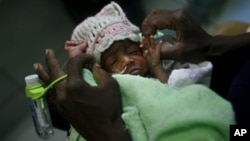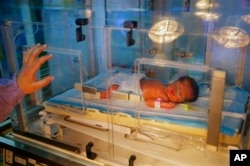People around the world observed World Prematurity Day Tuesday in an attempt to focus attention on the harm babies face when they are born too soon - before 37 weeks in the womb. The March of Dimes, an international advocacy group for child and maternal health, reports that for the first time, the complications of preterm birth now outrank all other causes as the world’s number one killer of young children.
Dr. Edward McCabe, the medical director of the March of Dimes, told VOA, "We’ve gotten some infectious diseases, diarrheal illnesses, malnutrition -- those have been going down, so we’re making good gains there. But preterm birth has not been going down in many countries. It’s been increasing." Thus, the global concern.
People took to Facebook and Twitter to express their feelings and to state their goals. One post read: "Malawi is also leading the charge in South Africa to raise awareness about #WorldPrematurityDay!" Malawi has the highest rate of premature birth in the world.
Other posters showed pictures of cities lit up in purple, the color of World Prematurity Day. There were photos from Wellington, Canberra and Sydney and buildings were lit up in Mexico City, Accra, Budapest and other places.
Adults born preterm posted pictures of themselves at birth. Some mourned babies who didn't make it.
The observance of World Prematurity Day began five years ago when organizations involved in preventing preterm births joined together to raise awareness of the lives lost and the problems it causes: blindness, reduced intellect and cerebral palsy among them.
Global problem
Approximately 15 million babies are born prematurely each year. That's more than one in 10 of all babies born worldwide, according to the World Health Organization. The WHO reports around 1 million of those babies die from complications of prematurity. More than 60 percent of preterm births occur in Africa and South Asia.
Some parts of the U.S. have higher rates of prematurity than some developing countries. In its annual report card for the United States, the March of Dimes gave the U.S. a mediocre grade overall. Some states got the lowest grade possible. Only four got the highest. No one knows all the causes of preterm birth, but McCabe said there "are a lot of disparities. Even states like California, which is doing well overall, have pockets that have just incredibly high preterm birth rates."
The March of Dimes has a two-stage plan to reduce prematurity in the states with the highest rates and then to expand the work to other regions. “We’re trying to be more strategic to help us focus our resources where they’re needed to improve the country and not leave the poorest performing areas, the poorest performing populations behind," McCabe added.
Dr. Regina Benjamin, a former U.S. Surgeon General, operates a clinic in rural Alabama, a state with an preterm birth rate of 11.5 percent or higher, depending on the area. It's also a state with a lot of African-Americans who have the highest rate of preterm birth of all the racial and ethnic groups in the U.S. "I've attended to babies who didn’t make it," Benjamin said. She recalled that in her early training a baby born prematurely often died. She credited the March of Dimes with changing that scenario. She now sits on the organization's board of directors.
Breastmilk may prevent blindness in preterm babies
Benjamin said in addition to implementing known strategies to reduce preterm birth, research is needed to address other causes. For example, research on preterm birth shows breastfeeding babies born prematurely could help reduce the risk of eye damage associated with prematurity. The study analyzed five studies from 2001 through 2013. Researchers found that preemies receiving mothers' milk had 46 to 90 percent lower odds of retinopathy of prematurity, depending on how much milk they received and how severe the condition was. The studies were observational, so they cannot show that breast milk directly caused the lower risk. The study involved researchers from China, Canada and the United Kingdom and included more than 2,200 preterm infants. The results were published online November 16 in the journal Pediatrics.
Watch video report:
Experts agree that more than three quarters of preterm babies could be saved through good pre- and post-natal care. And many lifesaving techniques cost nothing. For example, research shows that skin-to-skin contact between mother and baby, when the baby is wrapped to the mother's chest, improves a preemie's chances of survival. It keeps the baby warm and keeps the mother's attention on her baby, which prompts her to feed the baby more often, but the stimulation of skin-to-skin contact is the primary factor in helping these babies survive. The technique is called kangaroo mother care, and research shows it can work. Dr. Joy Law, previously of Save the Children, did research on this in 2010.
Roadmap
This year, the March of Dimes issued a "roadmap" to help reduce the number of pre-term births. Benjamin said the U.S. could reduce its overall rate of preterm births by simply implementing what is already known to reduce that risk.
The roadmap tells women to wait 18 months between the birth of one child and her next pregnancy. McCabe said this allows a woman's body to recover from one pregnancy before starting another one. This is the latest information from Stanford University, which has one of the five prematurity research centers in the U.S. funded by the March of Dimes.
"Recent research out of Stanford... showed that women who deliver preterm, have a different microbiome. Microbiome is the community of bacteria that’s in our mouth, between our teeth, and in various organs of our body," McCabe said. "Even the placenta, before it’s delivered, has been seeded with bacteria. In studying this microbiome, the vaginal microbiome, at Stanford they found that women who delivered preterm had a different community of microorganisms than women who delivered at term."
o Group Prenatal Care;
o Getting help to stop smoking before and during pregnancy, as smoking contributes to low birth-weight;
o Avoiding elective deliveries before 39 weeks of pregnancy, deliveries that are not medically necessary;
o Progesterone treatments for all women with a prior preterm birth, or a short cervix;
o Low-dose aspirin to prevent pre-eclampsia, a sometimes life-threatening condition, in women with high risk pregnancies;
o Preventing multiple births by following fertility treatment best practices.
At a conference addressing ways to prevent prematurity, Benjamin said, "Today in this room, we choose to conquer premature birth. It will not be easy. But it will serve to organize the best of our energies and our skills. It is a challenge that we accept, a challenge we’re not willing to postpone, and a challenge we intend to win."












